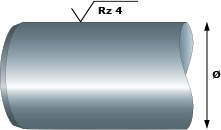Normally, for a slide bearing, the shaft acts as the opposing rotary partner. When choosing theshaft it is important to consider the surface roughness, the thermal conductivity and the hardness.
 The recommended surface roughness for a shaft, which is to run in a slide bearing, is a meansurface deviation of Ra = 0.2-1.6 μm and an average surface deviation, Rz = 1.25-8 μm. Thesevalues are only guidelines that can vary depending on the application. If a slide bearing is to beused in a measuring machine, with high requirements for precision, a fine tolerance is neededwhich requires a finer surface. We recommend that shafts with values higher than Rz = 4 μmare not used.
The recommended surface roughness for a shaft, which is to run in a slide bearing, is a meansurface deviation of Ra = 0.2-1.6 μm and an average surface deviation, Rz = 1.25-8 μm. Thesevalues are only guidelines that can vary depending on the application. If a slide bearing is to beused in a measuring machine, with high requirements for precision, a fine tolerance is neededwhich requires a finer surface. We recommend that shafts with values higher than Rz = 4 μmare not used.
Drawn shafts have been used with good results, especially with axial movements.
In a bearing, where the surrounding temperature and friction are such that they generate hightemperatures, a shaft with good thermal conductivity should be used.
The surface hardness of the shaft, where possible, should exceed 50 HRC.


